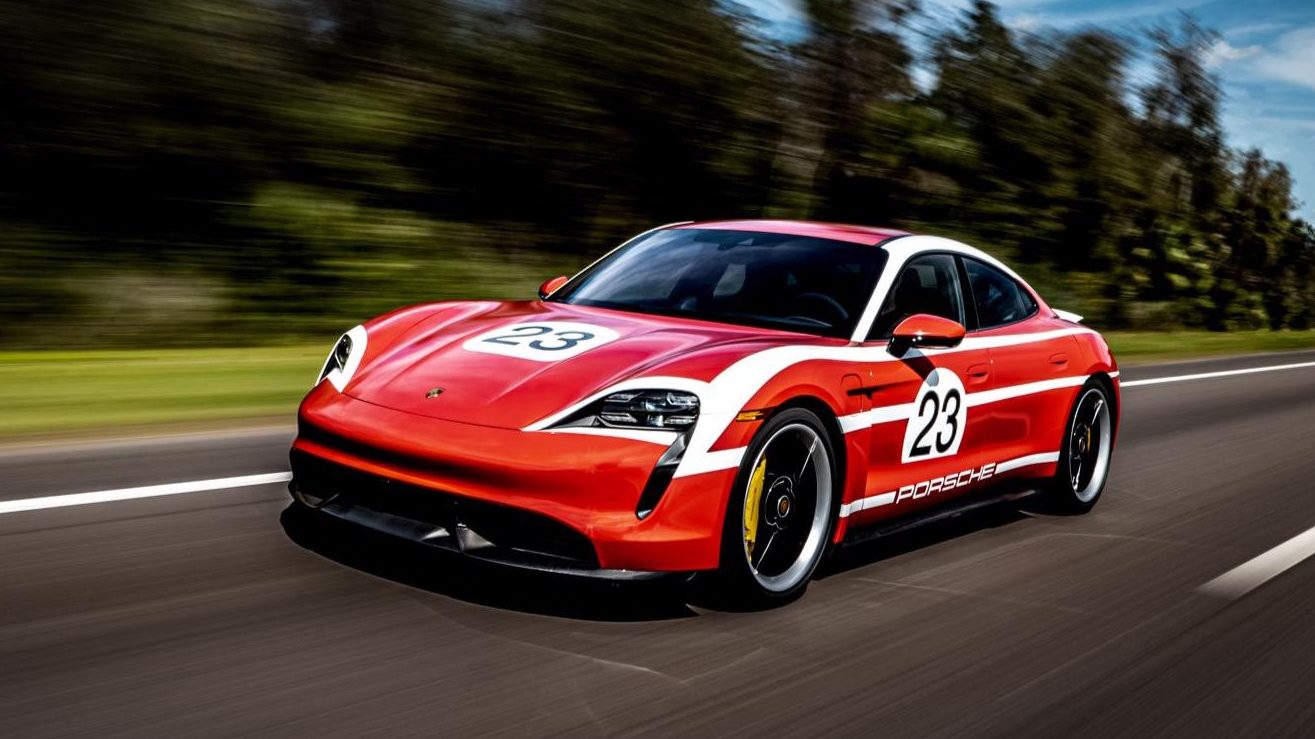My Pink Pig, still full of Haribos tumbling beneath its seats, had pre-existing marketing commitments at Amelia Island’s Werks Reunion on Friday, when I’d finally have time to stretch the Porsche Taycan’s legs on the empty backgrounds slicing through north Florida swampland. Any sadness I felt about saying goodbye to the porker lifted when a Salzburg-liveried Turbo S showed up in the hotel parking lot in its stead. Damn, it looks good in red and white.
Deputy Editor Jonathon Klein is driving a 2020 Porsche Taycan Turbo S from Atlanta to this weekend’s Amelia Island Concours d’Elegance. Read Part 1 of his report here.
These famously flat, straight roads, surrounded by Spanish moss-draped oak trees, aren’t exactly a dynamic driving experience. But Friday’s sunshine made up for it, shooing away the leaden clouds that had dumped buckets of rain throughout my entire 370-mile highway trek on Thursday. The wind had died down. And most importantly, the once-wet pavement was now dry and ready to stand up to the Taycan’s 774 pound-feet of instant torque.
Away from the glitz and the glamor, the Chopard watches, the vintage Rolls-Royces and Bentleys, and the prying eyes of the general public, I found a stretch of road that could’ve stood in for any NHRA drag strip. And I wasn’t the only one who thought so—the dead flat, arrow-straight route had already been scarred with endless elevens left by other scientists performing important research on the fastest way to vaporize rubber.
Without another soul in sight, I slowed to a stop and turned the Sport Response knob to Sport+, which lowers the ride height, pulls back the traction control settings to allow for a small amount of wheel-slip, stiffens the suspension, and gives you every ounce of the Taycan Turbo S’ 750 horsepower and 774 pound-feet of torque. I then put my left foot on the brake, the right hovering over the throttle, and simultaneously released the brake and mashed the accelerator.
Good gravy.

Violent launches aren’t anything new, and Porsche’s been delivering Christmas Tree savagery for almost two decades now. Yet there are few sports cars that come from the factory with the ability to match the electric Taycan’s off-the-line acceleration, with the $3 million, 1,600 horsepower Bugatti Chiron being the only vehicle I’ve driven that seems close—and that’s with a massive quad-turbo W-16 engine sitting just in front of the rear wheels. Even though the Taycan Turbo S is rated to hit 60 mph in 2.6 seconds compared to the Bugatti’s 2.5, the Porsche somehow feels quicker.
It’s hard to quantify when the numbers say otherwise, but I think that feeling comes down to an EV’s unhesitating torque delivery. All I can tell you is that you need to experience it.
Sport+ also turns on the Taycan’s Porsche Electric Sport Sound. Fake sounds are lame!, you shout. But Porsche’s solution to give its electric cars some sonic character isn’t fake. Engineers brought the entire drivetrain into a recording studio—sans Taycan body—and laid down a fat EV track, recording all the electric whirs and mechanical noises it made while being run to the limit. They then ran it through an equalizer, matched the recording to the car’s rpms, and turned the volume all the way up. So yes, it’s boosted in the well-insulated cabin, but there’s nothing artificial about what you’re hearing.
The result is a Blade Runner-esque score, both futuristic and somehow reminiscent of other Porsches. I absolutely love it. The sound should, by law, always be on—you can choose that in the car’s settings.

Back on my desolate road, I cracked off 0-60 mph runs repeatedly. Not once did the Taycan feel like it was running out of juice or needing a moment so that the car, the gearbox, or the batteries could be cooled to preserve their mechanical lives. I’d whack the throttle, slow down, and it’d ask almost immediately, “Please, sir, can I have another?” I obviously obliged.
Equally impressive are the Taycan’s brakes. It’s no easy feat to halt the momentum of a 5,121-pound all-electric four-door. That’s a helluva lot of mass to slow, but the standard on the Turbo S brakes are a set of truly massive 16.5-inch carbon ceramic rotors in the front, 16.1-inch carbon ceramic rotors at the rear, and 10-piston calipers up front, while 4-piston calipers make up the rear.
Wilder than its vice grip performance is how Porsche-like the featherable brake-by-wire system in the Taycan actually is. Left-foot braking is easy, and on the few corners I could find, the Taycan feels like it’s a car wanting to rotate under braking, not just throttle. This underlying persona peeking out every time I get behind the wheel has me eagerly awaiting a chance to either get the Taycan out onto a track or one of Los Angeles’ perfect mountain roads—I want turns, and the car does too.

I had to call it a day after a few hours, as sit-downs for The Drive Interview series with legendary racing driver Jacky Ickx and cinematographer and rally racer Jeff Zwart took up a fair chunk of my time—but trust me, those will be worth it. Today, I’m taking the Taycan out to the Brumos Collection in Jacksonville, Florida. The weather is supposed to continue to be beautiful and I’ll have more thoughts to digest. If you have more questions, or want specific thoughts on another area of the Taycan while I have the keys, let me know.
Got a tip? Send us a note: tips@thedrive.com
